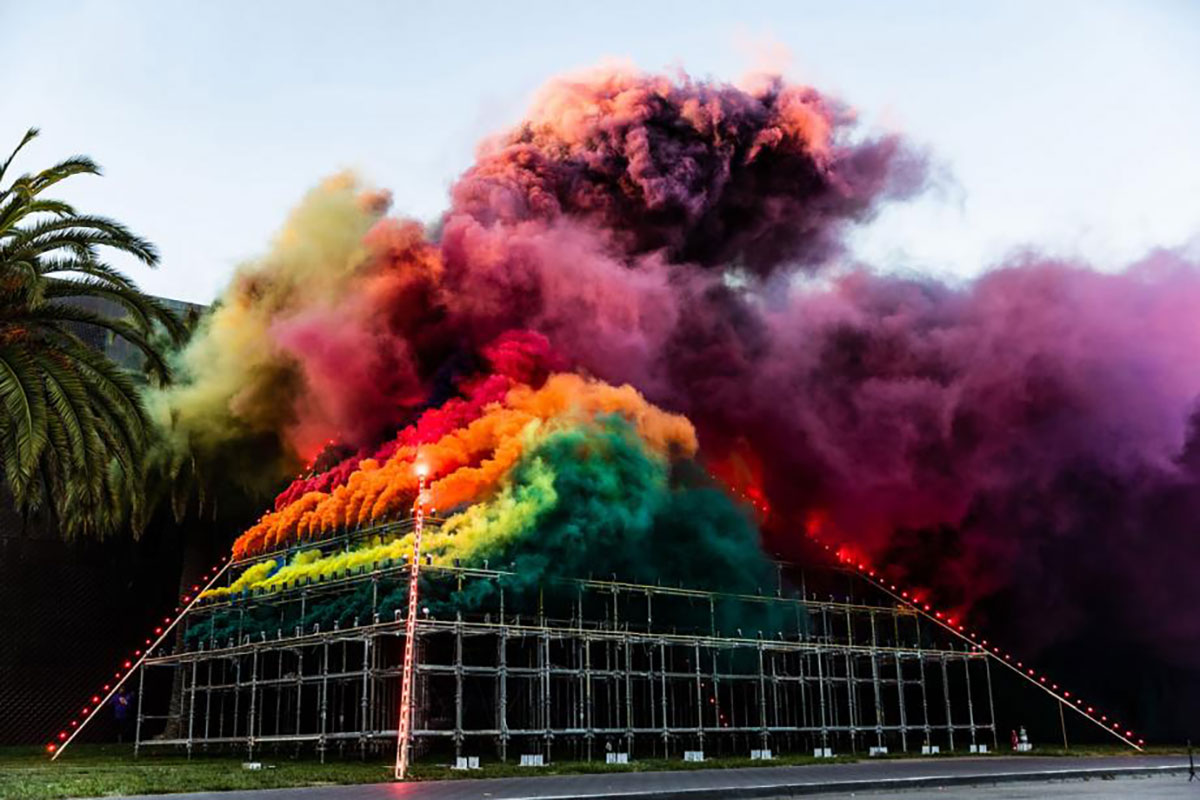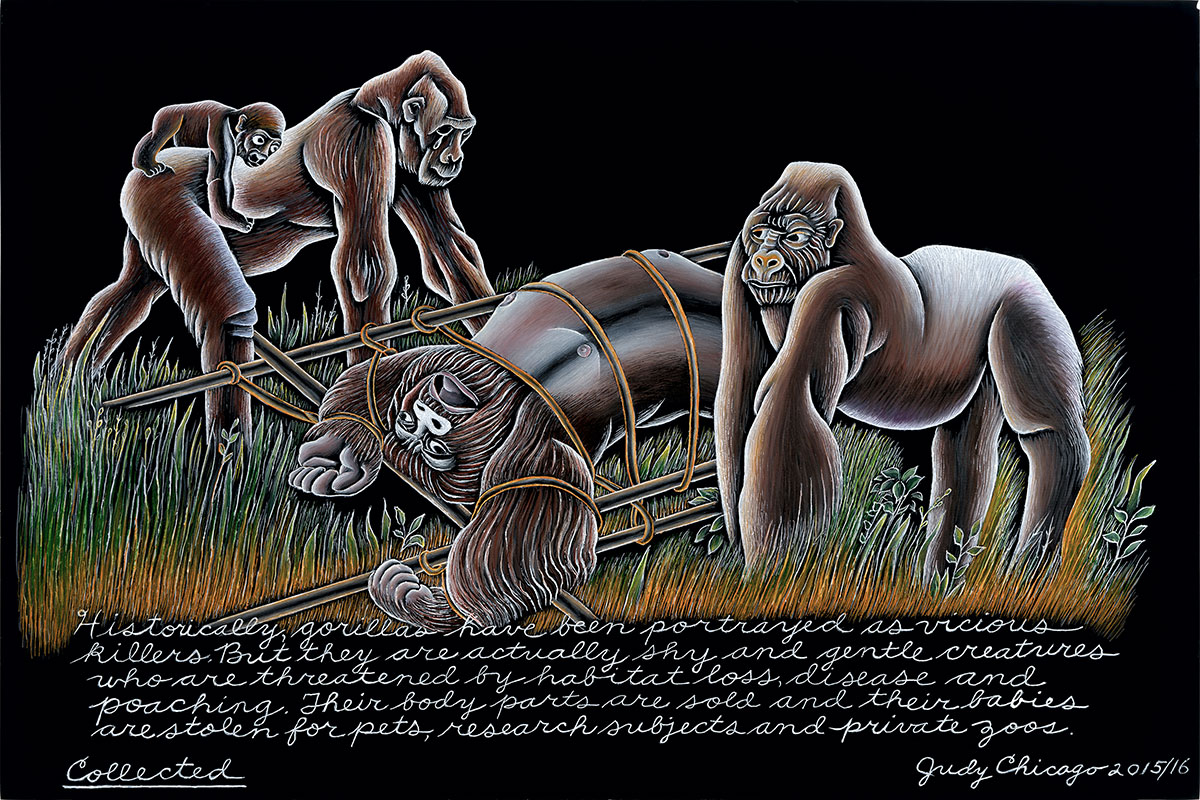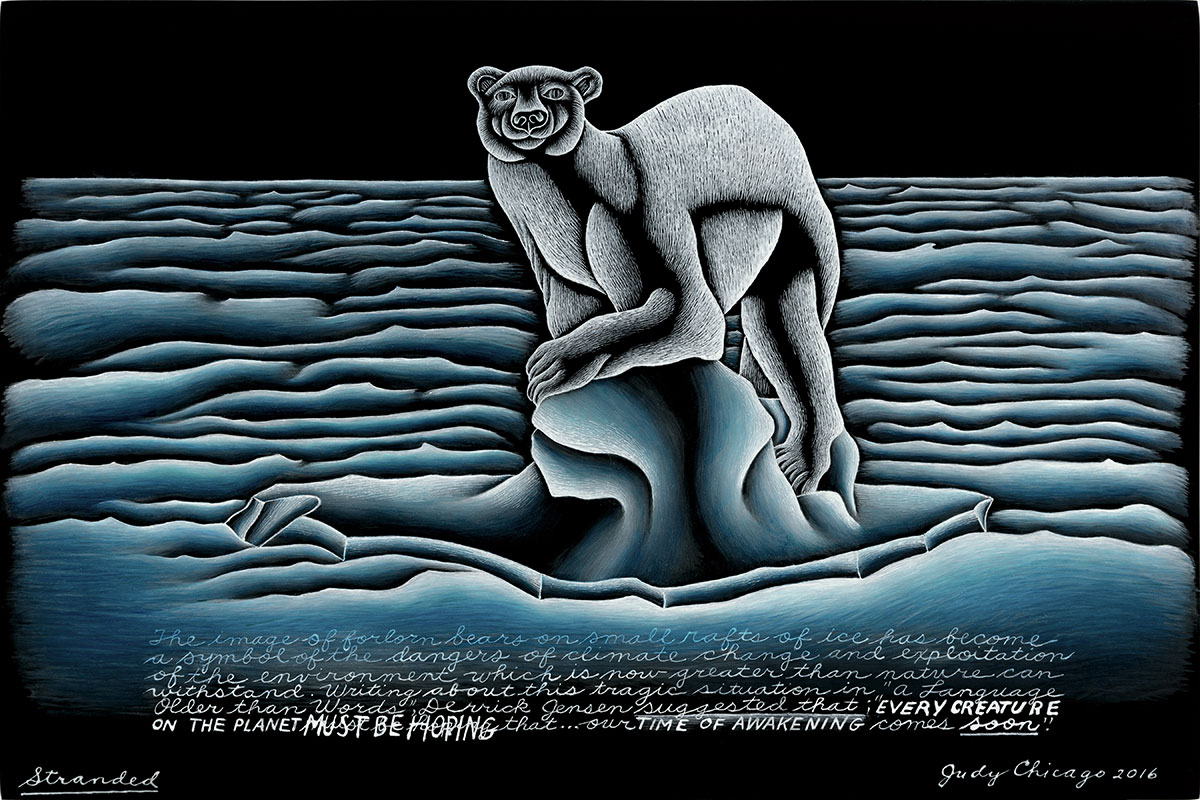PRESENTATION: Judy Chicago-Herstory
 Judy Chicago is an artist, author, feminist and educator whose career spans five decades, she is one of the pioneers of Feminist art that emerged in the late 1960s amidst the fervor of anti-war demonstrations and civil and queer rights movements. Her complex and focused installations created some of the visual context of the women’s liberation movement in the 1970s and beyond.
Judy Chicago is an artist, author, feminist and educator whose career spans five decades, she is one of the pioneers of Feminist art that emerged in the late 1960s amidst the fervor of anti-war demonstrations and civil and queer rights movements. Her complex and focused installations created some of the visual context of the women’s liberation movement in the 1970s and beyond.
By Dimitris Lempesis
Photo: New Museum Archive

The exhibition “Herstory” bringing together six decades of Judy Chicago’s work and including an exhibition-within-the-exhibition spotlighting women essential to the history of art and Chicago’s own practice. This is Chicago’s most comprehensive museum survey in New York to date ad spans three floors of the New Museum, tracing the artist’s sixty-year career across painting, sculpture, installation, drawing, textiles, photography, stained glass, needlework, and printmaking. On the Museum’s Fourth Floor, a total installation featuring Chicago’s embroideries, sculptures, drawings, and carpet design contextualizes her practice by bringing together artworks and archival materials from more than eighty women artists, writers, and cultural figures. Titled after fifteenth century author Christine de Pisan’s “The City of Ladies” continues Chicago’s work as a feminist activist and cultural historian claiming space for women in narratives that previously obscured or denied their contributions—much like her seminal work The Dinner Party (1974–79) in its attempt to create a history of important and often overlooked women. The exhibition encompasses the entirety of Chicago’s practice, from her 1960s experiments in Minimalism and her revolutionary feminist art of the 1970s to her series of the 1980s and 1990s—such as the “Birth Project” (1980–85), “Power Play” (1982–87), “Holocaust Project” (1985–93), “Resolutions: A Stitch in Time” (1994–2000), and “The End: A Meditation on Death and Extinction” (2012-1018)—which expand the purview of her Second Wave Feminist agenda to confront environmental disaster, genocide, social inequity, birth and creation, mortality, and the construct of masculinity. The exhibition includes legendary works such as “Rainbow Pickett”(1965), originally presented in “Primary Structures” at the Jewish Museum, an exhibition which consecrated the minimalist turn in contemporary sculpture; Atmospheres, her radical performances initiated in 1969 employing colored smoke and fireworks to activate rather than scar the landscape; a suite of visionary abstractions from the 1970s—such as “Through The Flower” (1973) and the “Great Ladies series” (1973)—exemplifying Chicago’s iconography rooted in feminist theory; the “Birth Project”, a cycle of dozens of works begun in 1980 combining needlework, embroidery, and painting to celebrate the birth process; and documentation of “Womanhouse,” the fabled 1972 installation staged in an abandoned Hollywood mansion by Chicago and Miriam Schapiro’s Feminist Art Program. These historic works are joined by recent series including “The End: A Meditation on Death and Extinction” (2012–18), exploring death as it affects both individuals and the planet, and “The Female Divine” (2022), a series of eleven monumental banners designed by Chicago and produced by the nonprofit Chanakya School of Craft in Mumbai posing questions such as “What if Women Ruled the World?” Tracing her prolific practice across many decades and intersecting art movements, the exhibition demonstrates the vast range and impact of Judy Chicago’s work over more than half a century. The exhibition also explores Chicago’s manifold contributions as a feminist activist and cultural historian, presenting her work in dialogue with other women artists, writers, and thinkers whose memory she has helped keep alive through her tireless activities as both researcher and historical preservationist. Combining artworks and source materials in a distinctive exploration of artistic influences and reverberations across history, this exhibition proposes a new, radical model for a solo exhibition—an “introspective,” rather than a retrospective. In this collaborative curatorial approach, the artist is invited to conceive a personal museum based on a model of historiography that is porous, hospitable, and accepting. Contextualizing Chicago’s feminist methodology within the many art movements in which she participated—and from whose histories she has frequently been erased, “Herstory” showcases Chicago’s tremendous impact on American art and highlights her critical role as a cultural historian claiming space for women often omitted from various canons.
The exhibition within “Her Story” entitled “The City of Ladies” includes work and archival materials from Hilma af Klint, Eileen Agar, Anni Albers, Lola Álvarez Bravo, Anna Atkins, Alice Austen, Djuna Barnes, Simone de Beauvoir, Otti Berger, Annie Besant, Hildegard of Bingen, Rosa Bonheur, Marianne Brandt, Nannie Burroughs, Claude Cahun, Julia Margaret Cameron, Leonora Carrington, Countess Virginia Oldoini Verasis di Castiglione, Elizabeth Catlett, Pop Chalee, Elizabeth S. Clarke, Ithell Colquhoun, Imogen Cunningham, Sonia Delaunay, Maya Deren, Emily Dickinson, Sophie Drinker, Suzanne Duchamp, Leonor Fini, Elsa von Freytag-Loringhoven, Olga Fröbe-Kapteyn, Artemisia Gentileschi, Gluck (Hannah Gluckstein), Emma Goldman, Natalia Goncharova, Martha Graham, Alice Guy-Blaché, Florence Henri, Barbara Hepworth, Hannah Höch, Kati Horna, Georgiana Houghton, Zora Neale Hurston, Frida Kahlo, Gertrude Käsebier, Käthe Kollwitz, Emma Kunz, Dorothea Lange, Edmonia Lewis, Mina Loy, Dora Maar, Jeanne Mammen, Maria Martinez, Maria Martins, Mary Louise McLaughlin, Maria Sibylla Merian, Paula Modersohn-Becker, Louise Nevelson, Maria Longworth Nichols Storer, Anaïs Nin, Georgia O’Keeffe, Méret Oppenheim, Agnes Pelton, Mary Richardson, Margaret Sanger, Augusta Savage, Ethel Smyth, Gertrude Stein, Varvara Stepanova, Florine Stettheimer, Dorothea Tanning, Sophie Taeuber-Arp, Toyen, Sojourner Truth, Remedios Varo, Pablita Velarde, Beatrice Wood, Virginia Woolf, and Unica Zürn, as well as a number of unattributed works.
Photo: Judy Chicago, Forever de Young. The smoke Sculpture was commissioned by the de Young Museum, San Francisco, as part of the artist’s retrospective. Photo by Scott Strazzante for Drew Altizer Photography, Courtesy of the Fine Arts Museum of San Francisco
Info: Curators: Massimiliano Gioni, Gary Carrion-Murayari, KrausMargot Norton, Assistant Curator: Madeline Weisburg, New Museum, 235 Bowery, New York, NY, USA, Duration: 12/10/2023-14/1/2024, Days & Hours: Tue-Wed & Fri-Sun 11:00-18:00, Thu 11:00-21:00, www.newmuseum.org/




Right: Judy Chicago, Doublehead with Gold Tear/Help Me, “PowerPlay” (1986), edition 6/12. Collection Jordan Schnitzer Family Foundation. © Judy Chicago/Artists Rights Society (ARS), New York. Photograph © Donald Woodman/ARS, NY






